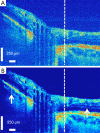State-of-the-art in retinal optical coherence tomography image analysis
- PMID: 26435924
- PMCID: PMC4559975
- DOI: 10.3978/j.issn.2223-4292.2015.07.02
State-of-the-art in retinal optical coherence tomography image analysis
Abstract
Optical coherence tomography (OCT) is an emerging imaging modality that has been widely used in the field of biomedical imaging. In the recent past, it has found uses as a diagnostic tool in dermatology, cardiology, and ophthalmology. In this paper we focus on its applications in the field of ophthalmology and retinal imaging. OCT is able to non-invasively produce cross-sectional volumetric images of the tissues which can be used for analysis of tissue structure and properties. Due to the underlying physics, OCT images suffer from a granular pattern, called speckle noise, which restricts the process of interpretation. This requires specialized noise reduction techniques to eliminate the noise while preserving image details. Another major step in OCT image analysis involves the use of segmentation techniques for distinguishing between different structures, especially in retinal OCT volumes. The outcome of this step is usually thickness maps of different retinal layers which are very useful in study of normal/diseased subjects. Lastly, movements of the tissue under imaging as well as the progression of disease in the tissue affect the quality and the proper interpretation of the acquired images which require the use of different image registration techniques. This paper reviews various techniques that are currently used to process raw image data into a form that can be clearly interpreted by clinicians.
Keywords: Image analysis; image registration; image segmentation; noise reduction; optical coherence tomography (OCT).
Conflict of interest statement
Figures









Similar articles
-
Application of Independent Component Analysis Techniques in Speckle Noise Reduction of Retinal OCT Images.Optik (Stuttg). 2016 Aug;127(15):5783-5791. doi: 10.1016/j.ijleo.2016.03.078. Optik (Stuttg). 2016. PMID: 27667860 Free PMC article.
-
Speckle Reduction in 3D Optical Coherence Tomography of Retina by A-Scan Reconstruction.IEEE Trans Med Imaging. 2016 Oct;35(10):2270-2279. doi: 10.1109/TMI.2016.2556080. Epub 2016 Apr 20. IEEE Trans Med Imaging. 2016. PMID: 27116734
-
Exact surface registration of retinal surfaces from 3-D optical coherence tomography images.IEEE Trans Biomed Eng. 2015 Feb;62(2):609-17. doi: 10.1109/TBME.2014.2361778. Epub 2014 Oct 8. IEEE Trans Biomed Eng. 2015. PMID: 25312906
-
Recent developments in optical coherence tomography for imaging the retina.Prog Retin Eye Res. 2007 Jan;26(1):57-77. doi: 10.1016/j.preteyeres.2006.10.002. Epub 2006 Dec 8. Prog Retin Eye Res. 2007. PMID: 17158086 Review.
-
Automatic Anisotropic Diffusion Filtering and Graph-search Segmentation of Macular Spectral-domain Optical Coherence Tomographic (SD-OCT) Images.Curr Med Imaging Rev. 2019;15(3):308-318. doi: 10.2174/1573405613666171201155119. Curr Med Imaging Rev. 2019. PMID: 31989882 Review.
Cited by
-
Segmentation guided registration of wide field-of-view retinal optical coherence tomography volumes.Biomed Opt Express. 2016 Nov 1;7(12):4827-4846. doi: 10.1364/BOE.7.004827. eCollection 2016 Dec 1. Biomed Opt Express. 2016. PMID: 28018709 Free PMC article.
-
A Deep Learning Approach to Denoise Optical Coherence Tomography Images of the Optic Nerve Head.Sci Rep. 2019 Oct 8;9(1):14454. doi: 10.1038/s41598-019-51062-7. Sci Rep. 2019. PMID: 31595006 Free PMC article.
-
Application of Independent Component Analysis Techniques in Speckle Noise Reduction of Retinal OCT Images.Optik (Stuttg). 2016 Aug;127(15):5783-5791. doi: 10.1016/j.ijleo.2016.03.078. Optik (Stuttg). 2016. PMID: 27667860 Free PMC article.
-
OCT Intensity of the Region between Outer Retina Band 2 and Band 3 as a Biomarker for Retinal Degeneration and Therapy.Bioengineering (Basel). 2024 May 1;11(5):449. doi: 10.3390/bioengineering11050449. Bioengineering (Basel). 2024. PMID: 38790316 Free PMC article.
-
Real-time OCT image denoising using a self-fusion neural network.Biomed Opt Express. 2022 Feb 14;13(3):1398-1409. doi: 10.1364/BOE.451029. eCollection 2022 Mar 1. Biomed Opt Express. 2022. PMID: 35415003 Free PMC article.
References
-
- Pizurica A, Jovanov L, Huysmans B, Zlokolica V, De Keyser P, Dhaenens F. Multiresolution Denoising for Optical Coherence Tomography: A Review and Evaluation. Current Medical Imaging Reviews 2008;4:270-84.
-
- Tomlins PH, Wang RK. Theory, developments and applications of optical coherence tomography. J Phys D: Appl Phys 2005;38:2519.
-
- Fercher AF, Hitzenberger CK, Kamp G, El-Zaiat SY. Measurement of intraocular distances by backscattering spectral interferometry. Optics Communications 1995;117:43-8.
-
- Chinn SR, Swanson EA, Fujimoto JG. Optical coherence tomography using a frequency-tunable optical source. Opt Lett 1997;22:340-2. - PubMed
Publication types
Grants and funding
LinkOut - more resources
Full Text Sources
Miscellaneous
